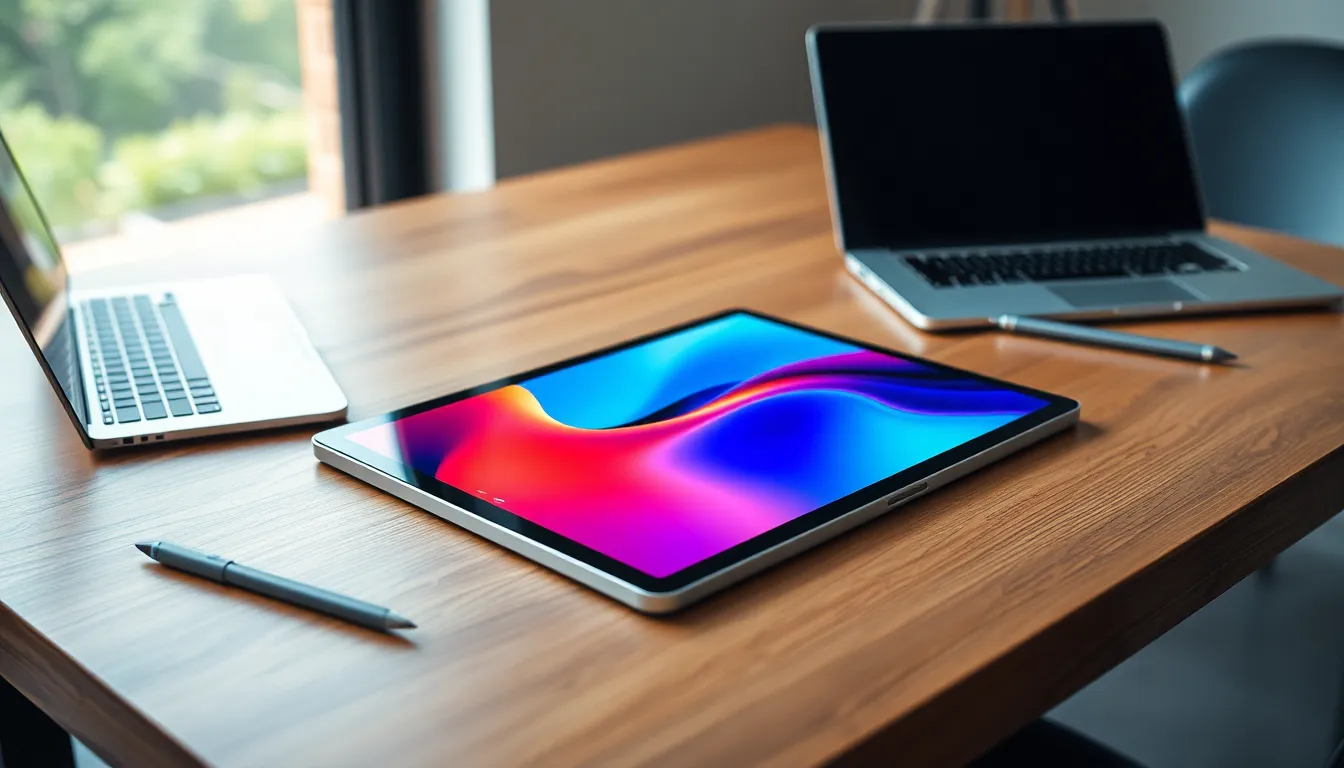Tablets have transformed the way people interact with technology, bridging the gap between smartphones and laptops. As these sleek devices continue to evolve, they’re becoming indispensable tools for work, education, and entertainment. With advancements in hardware and software, the future of tablets promises even greater functionality and user experience.
Emerging trends indicate that tablets will integrate more seamlessly with other devices, enhancing productivity and connectivity. Innovations in display technology, battery life, and processing power are set to redefine what users can expect from their tablets. As the demand for portable and versatile devices grows, the tablet market is poised for exciting developments that could reshape how individuals consume content and perform tasks in their daily lives.
Table of Contents
ToggleOverview of Tablet Evolution
Tablets evolved significantly since their inception in the early 2000s. Initially viewed as oversized smartphones, they quickly gained recognition for their versatility. The first popular models, like the Apple iPad released in 2010, showcased touchscreen interfaces that transformed user interaction.
Major Milestones in Tablet Development
- 2000s: Early tablet devices included the Microsoft Tablet PC, which featured stylus input and basic applications.
- 2010: Apple launched the iPad, marking the beginning of mainstream tablet usage, emphasizing multimedia and app integration.
- 2012: Android tablets gained popularity, expanding the market with diverse price points and capabilities.
- 2014 and beyond: High-performance devices emerged, featuring improved processors, larger screens, and enhanced battery life.
Changes in User Experience
Tables became increasingly user-centric, with a focus on intuitive navigation, responsive design, and an extensive library of applications. Tablets often serve as educational tools, providing interactive learning experiences and engaging content. As productivity needs grew, manufacturers introduced detachable keyboards and stylus support, catering to professionals and students alike.
Technological Advancements
Tablets benefited from advancements in hardware and software, including:
- Display Technology: Introduction of high-resolution screens and OLED technology, improving visual clarity.
- Processing Power: Enhanced processors, like Apple’s M1 chip, deliver desktop-level performance in portable packages.
- Battery Life: Innovations in battery technology allow for longer usage times, enhancing productivity on the go.
These developments established tablets as essential tools, bridging mobility and functionality across various fields.
Current Trends in Tablet Technology

Tablets are evolving quickly, reflecting major advancements in both hardware and software. These developments enhance user experience and broaden the device’s capabilities across various sectors.
Advancements in Hardware
Tablets now feature powerful processors, with many models equipped with ARM-based chips and Apple’s M1 and M2 silicon. Displays are improving, with 4K and OLED technology delivering superior visuals. Manufacturers increasingly focus on lightweight materials, offering devices that maintain portability without compromising durability. Battery technology is also advancing, with some tablets providing up to 15 hours of usage, facilitating long-term productivity. Additionally, many tablets support stylus inputs, enhancing creativity and precision in tasks like drawing and note-taking.
Software Innovations
Operating systems are becoming more tailored for tablet use, with features that facilitate multitasking, such as split-screen capabilities and enhanced app management. Popular applications are optimizing interfaces to leverage larger screens, promoting better user engagement. Cloud integration enables seamless file access and collaboration, ensuring users remain connected across devices. Furthermore, artificial intelligence is increasingly incorporated into tablet apps, improving user interaction by personalizing experiences and automating tasks. As a result, tablets are now equipped to support professional tasks traditionally reserved for laptops while maintaining mobile flexibility.
The Role of Tablets in Education
Tablets increasingly play a vital role in enhancing educational experiences. They provide versatile platforms for students and educators to engage with learning materials and harness technology to facilitate instruction.
Benefits for Students and Educators
- Enhanced Engagement: Tablets foster interactive learning environments. Educational apps and multimedia resources capture student attention and promote active participation.
- Accessibility: Tablets enable access to a wealth of resources. Students can retrieve e-books, online lectures, and research materials anytime and anywhere.
- Personalized Learning: Tablets support individualized learning pathways. They allow students to progress at their own pace, catering to diverse learning styles and needs.
- Collaboration Tools: Tablets include features that enhance collaboration. Applications for document sharing and real-time communication help students work together on projects.
- Cost-Effectiveness: Tablets can reduce educational costs. Digital textbooks and resources replace traditional materials, often at a lower price, making education more affordable.
Future Educational Applications
- Virtual Reality Integration: Tablets could incorporate virtual reality (VR) for immersive learning experiences. Students might explore historical sites or conduct science experiments in virtual labs.
- Augmented Reality Utilization: Augmented reality (AR) may enhance textbooks with interactive elements. Students could scan pages to reveal 3D models or additional information.
- Artificial Intelligence Tutoring: AI-driven applications might offer personalized tutoring experiences. These programs could adapt to individual learning progress and provide instant feedback.
- Remote Learning Solutions: Continued focus on remote education will encourage the development of robust platforms. Tablets may become central tools for online courses and virtual classrooms.
- Gamification Strategies: Educational games on tablets could boost motivation. Incorporating game elements into learning could transform routine activities into engaging challenges.
By embracing these advancements, tablets hold the potential to reshape educational landscapes and redefine how knowledge is acquired and shared.
Tablets in Business and Productivity
Tablets play an increasingly significant role in business and productivity, particularly in the domains of remote work and device integration. Their portability, versatility, and powerful capabilities make them essential tools for modern professionals.
Impact on Remote Work
Tablets enhance remote work by providing flexibility and ease of use in various settings. Many employees prefer tablets for video conferencing, document editing, and task management, leading to increased productivity. Trends indicate that 88% of employees using tablets report greater satisfaction in their remote working conditions. Tablets also support multiple applications, allowing professionals to seamlessly switch between tasks without losing focus. This adaptability helps maintain communication and collaboration, while cloud-based solutions further facilitate file sharing and real-time collaboration among team members, effectively bridging the gap between office and remote environments.
Integration with Other Devices
Tablets integrate smoothly with other devices, creating a cohesive digital ecosystem that boosts efficiency. Many tablets support Bluetooth and Wi-Fi connections, enabling users to link smartphones, laptops, and smart home devices effortlessly. Popular productivity tools, such as calendars, task managers, and note-taking apps, sync across tablets and computers, allowing professionals to access information and complete tasks on any device. The rise of cross-platform applications enhances this integration, making collaboration more efficient and streamlined. Notably, recent advancements in technologies like Universal Control allow for intuitive interaction between tablets and computers, reducing friction and enhancing workflow continuity.
Predictions for the Tablet Future
Tablets are set to evolve significantly with advancements in technology and changing market demands. These predictions highlight emerging technologies and market dynamics shaping the future of tablets.
Emerging Technologies
Emerging technologies will drive the next generation of tablets, enhancing their functionality and versatility.
- 5G Connectivity: Faster internet speeds through 5G will enable seamless streaming, cloud computing, and real-time collaboration.
- Foldable Displays: Foldable screen technology will allow for larger displays without increasing the device size, improving portability while enhancing the viewing experience.
- Artificial Intelligence Integration: AI algorithms will enhance user interactions by facilitating voice commands, predictive typing, and personalized content recommendations.
- Advanced Biometric Security: Enhanced security features, including biometric scanning and facial recognition, will ensure greater protection for user data.
- Improved Augmented Reality Experiences: AR capabilities will provide immersive applications for education, design, and gaming, revolutionizing user engagement.
Market Dynamics and Consumer Preferences
Market dynamics will influence tablet design, features, and usage patterns.
- Growing Preference for Hybrid Devices: Consumers increasingly favor tablets that combine laptop functionality with portability, leading manufacturers to focus on versatile devices.
- Demand for Enhanced Battery Life: Users prioritize devices that offer extended battery life, prompting innovations in energy-efficient technology and battery design.
- Shift toward Sustainable Materials: Eco-conscious consumers drive demand for environmentally-friendly tablets, pushing manufacturers to adopt sustainable materials and production practices.
- Increased Focus on Cloud Services: As more professionals rely on cloud-based applications, tablets that integrate seamlessly with cloud services will attract business users.
- Rising Remote Work Trends: The ongoing shift toward remote work boosts demand for portable devices that support multitasking and connectivity, reinforcing tablets’ role in the professional landscape.
These insights suggest that tablets will continue to evolve, driven by technological advancements and shifting consumer preferences, redefining how users engage with digital content in work, education, and entertainment.
The future of tablets looks promising as they continue to evolve and adapt to users’ needs. With advancements in technology driving improvements in performance and functionality, tablets are set to become even more integral in various aspects of life. Their role in education and business is expanding, providing innovative solutions for remote work and interactive learning.
As manufacturers embrace new technologies like AI and 5G, tablets will offer enhanced connectivity and user experiences. The trend toward hybrid devices and sustainable materials indicates a shift in consumer preferences, ensuring tablets remain relevant in a fast-paced digital landscape. Ultimately, tablets are poised to transform how individuals engage with technology, making them indispensable tools for the future.


